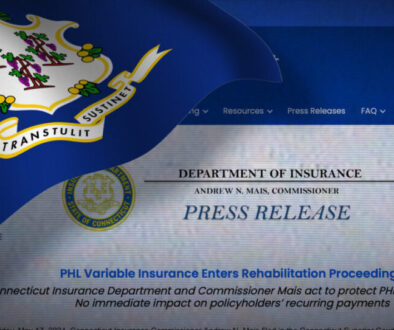Private equity stake in life insurers draws new round of critical reports
Private equity firms continue to stalk insurance company takeovers and critics say the potential for a financial disaster grows along with that trend.
Americans for Financial Reform, a Washington, D.C.-based nonprofit group that advocates for stronger regulation of Wall Street firms, is the latest group to raise alarm bells on what it deems to be risky private equity investment of policyholder funds.
AFR’s new study grew out of its analysis of the relationship between private equity and public pension funds, said Andrew Park, senior policy analyst for the group. The PE impact on pensions is now understood, he explained.
“What has been less understood is how much of this new capital that private equity is getting is coming from the acquisition of insurance companies, and then in turn, insurance companies buying up a lot of the assets that private equity tends to originate,” he added. “It’s almost like you have this circular financing scheme that has been created now with private equity and insurance.”
By the second half of 2023, private equity firms owned $774 billion in life insurance assets, or 9% percent of the life insurance industry, according to the AM Best insurance analyst. Likewise, PE firms are estimated to manage $5.7 trillion in global assets, giving these firms ample ability to buy up even more insurance companies, AFR noted.
The AFR report, Risky Business: Private Equity’s Life Insurance Gambit, comes amid growing pressure on private equity firms to submit to stronger oversight. Over the past month, the Financial Stability Oversight Council and the International Monetary Fund both released their own reports questioning private-equity control of insurers.
FSOC is a Treasury Department panel formed to assess and mitigate risks to the financial system. The three reports come to similar conclusions: regulators need to step up and better monitor private equity and the insurance funds they control.
An “area of focus is on increased investment allocations by insurers to complex structured securities, such as [collateralized loan obligations], and assessing whether regulators have the proper tools, as well as a supervisory and capital framework, in place to effectively protect policyholders from insurers’ investment risk,” the FSOC report said.
Aon study: no greater risk
The American Investment Council pointed to a 2022 study it commissioned from Aon Inpoint, in which the consultant reviewed the investment trends of alternative asset management-owned insurers. Alternative asset management is a broader term for private equity firms.
The study acknowledged the default record of mortgage-backed securities, which precipitated the 2008-09 financial crisis. However, today’s asset-backed securities [ABS] do not come with the same risks, the Aon study noted, and have default rates comparable to, or lower, than similarly rated corporate bonds.
Looking at investments from the years, 2010, 2015 and 2021, the Aon study concluded that alternative asset management-owned insurance companies “maintain a similar credit risk level to non-AAM-owned insurers despite the varying concentration of ABS and corporate bonds.”
“As investment managers, private capital firms have a long history of successfully and safely managing insurance capital to deliver strong performance for policyholders,” said Drew Maloney, CEO of the AIC. “Insurers, whether publicly traded or privately held, are subject to the same stringent regulation.”
Pot of gold for private equity
The private equity insurance buying spree dates to the 2008 financial crisis but picked up significantly in recent years. At the end of 2022, private equity firms owned 137 U.S. insurance companies with $533.7 billion in assets representing 6.5% of total U.S. insurance assets, according to data from the National Association of Insurance Commissioners.
The private equity hunt for insurance assets involves the biggest names on Wall Street. In a 2021 deal, Global Atlantic Financial Group was acquired by global investment company KKR & Co. for $4.4 billion.
Other huge deals saw Apollo combining with Athene and Blackstone buying a 9.9% chunk of AIG’s Life & Retirement business as part of an ongoing, longer-term relationship.
As the deals got bigger regulators and consumer advocates became more concerned. If policyholder funds are subjected to greater risk, it could create a chain-reaction disaster for the entire financial system, Park said.
“Insurance companies are deeply interconnected with the broader financial system — as investors, counterparties, lenders, and underwriters — so foundering insurance companies or sector-wide losses from common insurance investment strategies can reverberate across the economy and pose systemic financial risks,” the AFR reads.
Collateralized loan obligations
One riskier investment area that concerns groups like AFR is collateralized loan obligations, or CLOs. A CLO is a single security backed by a pool of debt. They are often backed by corporate loans with low credit ratings or loans taken out by private equity firms to conduct leveraged buyouts.
McKinsey reported that 80% of private equity-owned insurers shifted their investments into higher-risk securities, especially CLOs. Private equity-owned insurance investments in CLOs have tripled over the past five years from $4.3 billion in 2018 to $12.9 billion in 2022 and represented a growing share of bond investments, the NAIC reported.
A year ago, the NAIC tweaked its rules in order to tie CLO capital charges to the NAIC’s own modelling rather than CLO ratings. Regulators did so to remove an inconsistency in the rules that results in insurers holding less capital against CLOs than they do against the underlying loans that CLOs hold.
NAIC regulators have stepped up oversight of PE involvement with life insurance ownership in recent years. That work is focused in the Macroprudential Working Group, which adopted a list of “13 considerations” applicable to PE-owned insurers.
“The state insurance solvency framework includes significant checks and balances to protect policyholders, including many public and non-public disclosures and statutory requirements, and these are used to assess risks to all insurers, regardless of the type of ownership,” the NAIC said in an October statement to InsuranceNewsNet. “Private equity ownership of insurers is not a new thing; state insurance regulators adopted new regulatory guidance in 2013 to identify and address the different risks of PE owners.
“What is new is the volume of such transactions and the increased complexity of investments for most insurers in general.”
Call to action
State insurance regulators are not eager to cede any oversight duties to the federal government. Ongoing attempts by federal regulators to collect climate data and regulate annuity sales are met with repeated resistance from the NAIC and its members.
Setting aside those turf battles is imperative to responsibly regulating the private equity control over insurance companies, Park said.
“There is no one regulator that is responsible at looking at collectively at how the activities of insurance companies are posing threats to the entire financial system,” he explained.
AFR is proposing several reforms to address private equity management of insurers.
“State insurance commissioners should strengthen oversight of private equity owned insurers by imposing and strictly enforcing quantitative caps on affiliated transactions, improving the disclosure and pre-approval of affiliated transactions, limiting the asset management fees private equity firms charge their insurance portfolios, and raising capital reserve requirements on insurers’ riskier non-investment grade holdings and on structured bonds, including treating insurance company holdings of CLOs more similarly to the way it treats holdings of the underlying leveraged loans,” the report recommends.
Likewise, the group supports giving federal regulators the power to designate insurance companies as “systemically important financial institutions,” which would bring them under the direct supervision of the Board of Governors of the Federal Reserve System.
“The rise in private equity-owned insurers can pose real risks to policyholders and even the broader economy, as private equity firms shift staid insurance portfolios into riskier investments,” said Patrick Woodall, senior fellow at AFR. “If private equity-owned insurers’ losses mount, they could be unable to meet their obligations and policyholders could lose portions of their life savings or face years of delays getting claims paid if their insurer collapses.”
InsuranceNewsNet Senior Editor John Hilton covered business and other beats in more than 20 years of daily journalism. John may be reached at john.hilton@innfeedback.com. Follow him on Twitter @INNJohnH.
© Entire contents copyright 2024 by InsuranceNewsNet.com Inc. All rights reserved. No part of this article may be reprinted without the expressed written consent from InsuranceNewsNet.com.
The post Private equity stake in life insurers draws new round of critical reports appeared first on Insurance News | InsuranceNewsNet.




